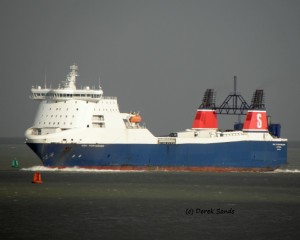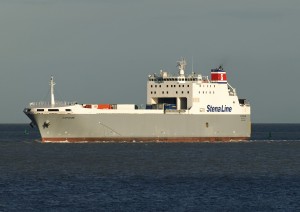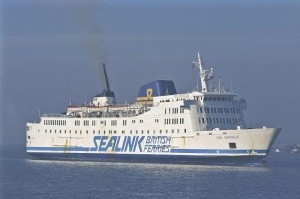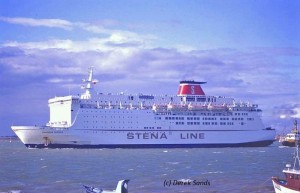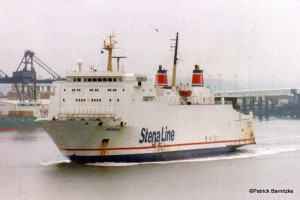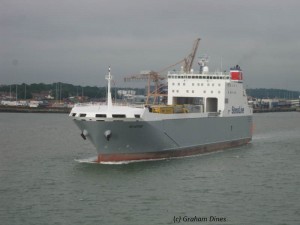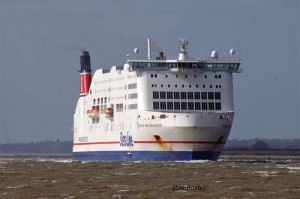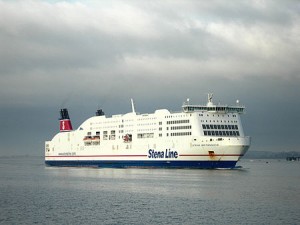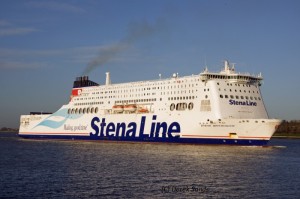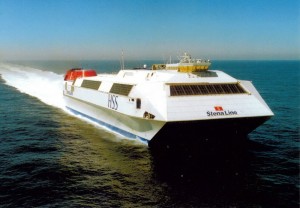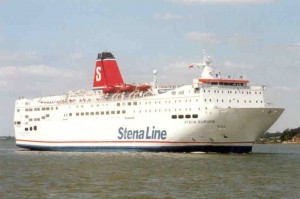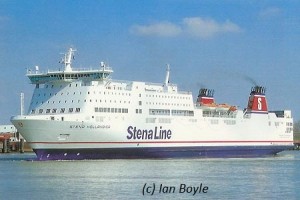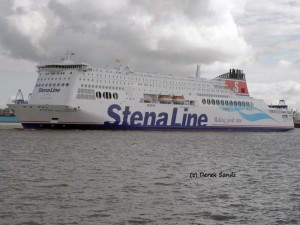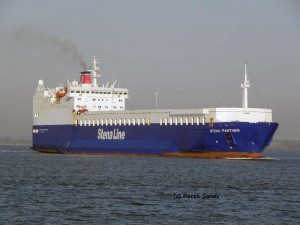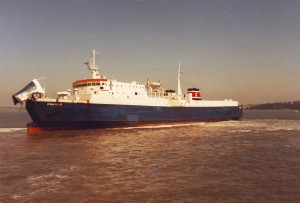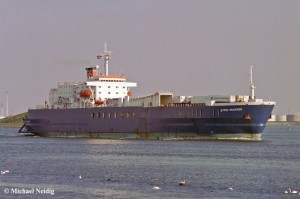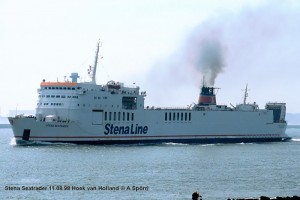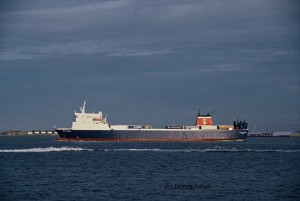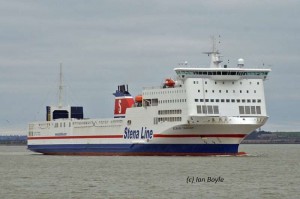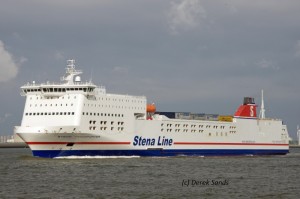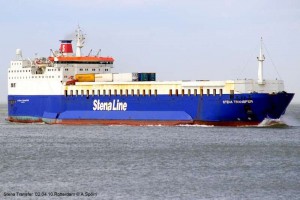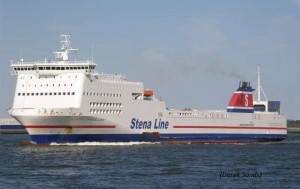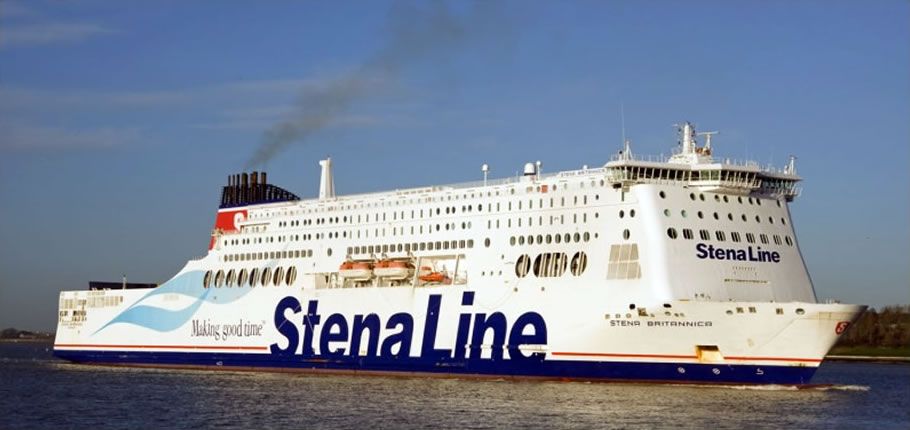
Stena Line
A Passenger service has operated from Harwich to Hook van Holland since the late 19th century apart from a break during the Second World War. In 1883, the Great Eastern Railway moved its English base from Harwich to Parkeston Quay and in 1893 moved its Dutch operations from Rotterdam to the new rail terminus at the Hook of Holland. The new terminal in the Hook was situated on the north western end of the New Waterway and this saved two hours on the passage to Rotterdam itself. The new route enabled passengers to leave London in the evening and, after arrival in the Hook before 6 am, be in Amsterdam at breakfast time and reach Berlin by the end of the day.
By 1904, the GER had ceased operations to Rotterdam. The Dutch had their own services from Flushing, which was operated by Stoomvaart Maatschappij Zeeland (SMZ) which was created in 1875, which ran firstly to Queenborough near Sheerness and then to Folkestone.
On 1 January 1923 after the enforced re-grouping of the railway companies, the route came under the control of the London and North Eastern Railway.
In 1926, SMZ moved its English port to Harwich providing day sailings but did not start using the Hook of Holland until after the Second World War.
Post Second World War vessels on this route included the John Brown built Arnhem (1946). On 1 January 1948, after the nationalising of the British railway network, the route came under the control of British Railways. In 1950, the Amsterdam, also built by John Brown, came into service; in 1963, the elegant Avalon was built for this route. SMZ added the motor ship the Koningin Wilhelmina in 1960.
Until 1990, the route was operated by two companies: one British and the other Dutch; but since then, Stena Line BV has been operating this route.
Ark Forwarder
- Built. 1998 (IMO 9138783)
- Yard. Societa Esercizio Cantieri Spa, Viareggio. Italian.
- Class of Ship. Cargo
- Operator. Stena Line
- Route. Harwich-Rotterdam 2010-2012
- Length. 182.60 m
- Gross Tonnage. 21004
- Passengers. 12
- Freight Capacity. 2715 Lane metres
- Speed. 22 Knots
- Status. Ark Forwarder
- History:
- 11/10/1997 Launched as Stena Ausconia
- 30/08/2005 Renamed Stena Forwarder.
- 20/12/2010 Rotterdam – Harwich.
- 2012 End of Charter
Capucine
- Built. 2011 (IMO 9539066)
- Yard. Kyokuyo Shipyard, Shimonoseki, Japan.
- Class of Ship. Cargo
- Operator. Stena Line
- Route. Harwich-Rotterdam
- Length. 152.00 m
- Gross Tonnage. 16342
- Passengers.
- Freight Capacity. 1760 Lane metres
- Speed. 17.5 Knots
- Status. Capucine
M/S Capucine was launched on the 17 November 2011 and was chartered to Stena Line from January 2012 on the Harwich-Rotterdam route.
Earl Granville
- Built. 1973 (IMO 7310258)
- Yard. Jos L Meyer
- Class of Ship. Passenger
- Operator. Sealink
- Route. Harwich-Hook of Holland 1989
- Length. 108.72 m
- Gross Tonnage. 4657
- Passengers. 1200
- Freight Capacity. 265 cars
- Speed. 19 Knots
- Status. Scrapped 2005
History: Express Olympia (1990-2005) Earl Granville (1980-1990) Viking 4 (1973-1980).
When the St Nicholas sailed for her annual overhaul from 8th January 1989-19th January 1989, her schedules were taken over by the Channel Island ferry Earl Granville, while ro-ro traffic was transported by the Mercandian Universe.
Koningin Beatrix
- Built. 1985 (IMO 8416308)
- Yard. Van der Gissen de Noord
- Class of Ship. Passenger
- Operator. Stena Line
- Route. Harwich – Hook of Holland 1986-1997
- Length. 164.61 m
- Gross Tonnage. 31910
- Passengers. 1200
- Speed. 20 Knots
- Status. SNAV Adriatico
Koningin Beatrix was built in 1986 by Van der Gissen De Noord, for Stoomvaart Maatschappij Zeeland N.V (SMZ). She was used on their joint Harwich-Hook of Holland service with Sealink. The SMZ service was marketed as Crown Line. In 1989, the SMZ operation was sold to Stena Line BV. Ownership of Koningin Beatrix passed to Stena Ab, and she was chartered to Stena Line BV. In 1997 she was transferred to the Stena Line Fishguard-Rosslare route, when replaced by HSS Stena Discovery. In 2002 she was transferred to the Karlskrona-Gdynia route and renamed Stena Baltica, swapping with Stena Europe.
The SNAV Adriatico was built in 1986 by Van der Giessen de Noord as the Koningin Beatrix. She entered service the same year sailing between Hoek van Holland and Harwich for SMZ. In 1989 Stena Line took over the route. She remained on that route until 1997 when she was replaced by the Stena Discovery.
Following the arrival of the Stena Discovery the Koningin Beatrix was transferred to the Fishguard – Rosslare route, replacing the Stena Felicity. She remained on the Fishguard – Rosslare Harbour route until 2002, when she was replaced by former Stena Line BV fleetmate Stena Europe.
In 2003 the Koningin Beatrix was transferred to the Karlskrona – Gdynia route and renamed Stena Baltica.
Rosebay
- Built. 1976 (IMO 7429229)
- Yard. JI Sietas
- Class of Ship. RORO
- Operator. Stena Line
- Route. Harwich – Rotterdam 1994-2000
- Length. 136
- Gross Tonnage. 13867
- Passengers. 63
- Freight Capacity. 1624 Lane metres
- Speed. 17 Knots
- Status. Scrapped 29/05/1914
Rosebay was built in 1976 by J. J. Sietas Werft, Hamburg, and West Germany for Poseidon Schiffahrts OHG as MS Transgermania. Renamed Rosebay in 1993 and Chartered by Stena Line for service between Harwich and Rotterdam from July 1994 until October 2000.
Severine
- Built. 2012 (IMO 9539078)
- Yard. Kyokuyo Shipyard, Shimonoseki, Japan.
- Class of Ship. RoRo cargo
- Operator. Stena Line
- Route. Harwich-Rotterdam 2012-
- Length. 152,00 m
- Gross Tonnage. 16,342
- Passengers.
- Freight Capacity. 1760 Lane metres
- Speed. 17.5 Knots
- Status. Severine
M/S Severine was launched in 2012 by Kyokuto Shipyard, Shimonoseki, Japan and was chartered by Stena Line in September 2012 for the Harwich-Rotterdam service.
Stena Britannica
- Built. 1981 (IMO 7911545)
- Yard. Cammell Laird Shipbuilders Ltd., Birkenhead
Class of Ship. Passenger - Operator. Stena Line
- Route. Harwich-Hook of Holland 1991-1994
- Length. 166.10 m
- Gross Tonnage. 25905
- Passengers. 2000
- Freight Capacity. 450 cars, 70 trailers
- Speed. 22 knots
- Status. Stena Saga
The former Silvia Regina which Stena Line had purchased three years previously and which now became the Stena Britannica. The ship was built in 1991 and arrived at the Hook of Holland at 13.00 on the 17th June 1991. The ship was luxurious throughout and a more equal partner for the Koningin Beatrix in terms of cabins and facilities. On 1st June 1993 the Harwich – Hook of Holland route marked its centenary and following their annual overhauls both the Stena Britannica and Koningin Beatrix emerged in January and February respectively displaying a special 3,5-diameter ‘100 years’ logo painted on their hulls.
The ship was not economic to use on the Hook van Holland – Harwich route, and in March 1994 she was moved to the Oslo–Frederikshavn route, taking over the route and the name of MS Stena Saga.
Stena Britannica III
- Built. 2000 (IMO 9145164)
- Yard. Kapellskar
- Class of Ship. Passenger
- Operator. Stena Line
- Route. Harwich-Hook of Holland 2000-2010
- Length. 188,3 m
- Gross Tonnage. 33,769
- Passengers. 9452
- Speed. 22 Knots
- Status. Finnfellow
Stena Britannica (III) was one of four sisters in the Stena Seapacer series ordered by Stena Ro-Ro from Spanish builders. The first two sisters, built in 1999, became the Finnclipper and Finneagle of Finnlines. Stena Britannica (3) was built in 2000, and chartered to Stena Line BV for their new Ro-Pax service between Harwich-Hook of Holland. This service was so successful that a larger ship was needed on the overnight services from Holland. In February 2003 Stena Britannica (3) was replaced by the Korean-built Stena Britannica II, later renamed Stena Britannica (4). Stena Britannica (3) was sold to Finnlines as Finnfellow.
The success of the Harwich-Hook ro-pax service introduced with the Stena Britannica in 2000 was such that a larger vessel was required on the overnight services from Holland. Stena Britannica II was delivered from Korea in February 2003.
Stena Britannica II
- Built. 2002 (IMO 9235517)
- Yard. Hyundai Heavy Industries, Korea
Class of Ship. Passenger - Operator. Stena Line 2002-2010
- Route. Harwich-Hook of Holland
- Length. 211.56 m
- Gross Tonnage. 43387
- Passengers. 900
- Freight Capacity. 3400 Lane Metres
- Speed. 22.5 knots
- Status. Stena Scandinavica
The Stena Britannica began operations between Harwich and the Hook of Holland back in 2002 along with sister ship Stena Hollandica, the last sailing was on the 9th October 2010.
- History: Stena Scandinavica IV (2011) Britannica (2010-2011) Stena Britannica (2003-2010)
- Stena Britannica II (2002-2003)
Stena Britannica
- Built. 2010 (IMO 9419175)
- Yard. Wadan Yards, Wismar, Germany
- Class of Ship. Passenger
- Operator. Stena Line
- Route. Harwich-Hook of Holland 2010-
- Length. 240 m
- Gross Tonnage. 63039
- Passengers. 1200
- Speed. 22 knots
- Status. Sailing
The Stena Britannica was launched at the end of 2010, and is the second of two identical Ro Pax ferries built by Wadan Yards in Warnemünde, Germany for Stena Line. Both ships operated across the southern North Sea between Harwich and Hook van Holland providing a twice daily service from each side.
Total value of the order amounted to approximately €400 million. Delays arose when Stena temporarily withdrew the order in response to economic difficulties being experienced by Waden Yards. After further negotiations the order was reinstated, but the new agreement included a price cut of 6% or approximately €24 million. The ships having been completed, naming ceremonies took place on 8 June 2010 for the “Stena Hollandica” at the Hook of Holland and on 19 October 2010 at Harwich for the “Stena Britannica”.
Stena Discovery
- Built. 1996 (IMO 9107590)
- Yard. Finn Yards, Rauma, Finland
- Class of Ship. Passenger Ferry
- Operator. Stena Line 1997-2007
- Route. Harwich-Hook of Holland
- Length. 120.6 m
- Gross Tonnage. 19638
- Passengers. 1500
- Freight Capacity. 375 Cars, 800 Lane Metres
- Speed. 40 knots
- Status. Scrapped 2015
Stena Discovery was built in 1997 by Finnyards, Rauma, Finland as the third large HSS ferry when she entered service, the conventional passenger ferries Stena Europe and Koningin Beatrix were transferred to other routes, so the HSS had no backup when services were cancelled due to weather.
There were two round trips. Departure times from the Hook were at 07.15 and 16.10 with return departures from Harwich at 10.50 and 19.30. Crossing times would be 3 hours 40 minutes with turn-round times of between 40 and 50 minutes.
In 2000 she was joined by the first of two large ro-pax ferries which both offered passenger accommodation, the Stena Britannica (3). Stena Discovery was withdrawn from the Harwich-Hook route on 8th January 2007 due to increasing fuel costs.
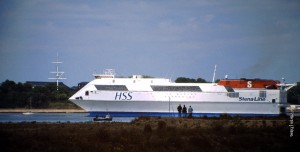
Approaching Parkeston Quay
The vessel operated between Harwich and Hoek van Holland for Stena Line from its introduction in 1997 until January 2007 when it was taken out of service due to its high fuel consumption. The vessel was laid up at Belfast between January 2007 and September 2009, before departing for La Guaira, Venezuela under the ownership of Albamar Shipping Company. Prior to its departure from Belfast, the “Stena” prefix was removed from the vessel’s name.
As the Stena Discovery, the vessel operated between Harwich and Hoek van Holland for Stena Line from its introduction in 1997 until January 2007 when it was taken out of service due to its high fuel consumption. The vessel was laid up at Belfast between January 2007 and September 2009, before departing for La Guaira, Venezuela under the ownership of Albamar Shipping Company. Prior to its departure from Belfast, the “Stena” prefix was removed from the vessel’s name.
It served only shortly in Venezuela and was put out of service again in 2009. In November 2011, it was moved to the caribbean island of Curacao in an attempt to attract investors for a new ferry service from Curacao to La Guaira. It was subject to a criminal investigation shortly afterwards regarding irregulatory trade of diesel from the ballast tanks.
Stena Europe
- Built. 1981 (IMO 7901760)
- Yard. Gotaverken, Gothenburg
- Class of Ship. Passenger
- Operator. Stena Line 1983-1991
- Route. Harwich-Hook of Holland
- Length. 149.05 m
- Gross Tonnage. 24828
- Passengers. 2076
- Speed. 19 knots
- Status. Stena Europe
Stena Europe was built in 1981 by Götaverken Arendal Rederi Ab for Goteborg-Frederikshavn Linjen (Sessan Linjen) as the Kronprinsessan Victoria. She entered service on the Goteborg-Frederikshavn route. In 1982, Stena line acquired a majority interest in Sessan Linjen, and Kronprinsessan Victoria moved to the Goteborg-Kiel route.
In 1988 MS Kronprinsessan Victoria was sent for rebuilding to make her more suitable for use on the Oslo – Frederikshavn route, this involved building more cabins which saw an accommodation block added on the top deck. MS Kronprinsessan Victoria was renamed MS Stena Saga prior to entering service on the Oslo – Frederikshavn route.
In 1994 the vessel was transferred to the Hoek van Holland – Harwich route. MS Stena Saga was refitted prior to transfer, this mainly involved removing the accommodation block that was added to the top deck in 1988. The vessel was then renamed MS Stena Europe.
Following the introduction of the HSS Stena Discovery on the Hoek van Holland – Harwich route in June 1997 the MS Stena Europe was withdrawn from the route. She was transferred to Stena Line’s subsidiary Lion Ferry as MS Lion Europe entering service on the Karlskrona – Gdynia route.
In 1998 all Lion Ferry routes and vessel were transferred to the Stena Line banner. Following this she reverted to the name Stena Europe. Between 1997 and 2001.
Late 2001 Stena Line announced that the MS Koningin Beatrix and MS Stena Europe would swap routes in early 2002. In January 2002 MS Stena Europe entered the City Shipyard at Gothenburg to undergo a GBP4.5 million refit. All the main passenger lounges were refurbished and the cabins installed on the upper vehicle deck in 1982 were removed returning the latter to something like their original state. With freight capacity fully restored the vessel is once again very much a day ferry. Following berthing trials the MS Stena Europe entered service on its new route on 13 March 2002.
In June 2005 MS Stena Europe covered on the Holyhead – Dublin route for eleven days while MS Stena Adventurer was on annual overhaul. In November 2008 MS Stena Europe received an €850,000 refurbishment to some of its main passenger lounges. The most recent interior upgrade was completed in May / June 2010 which brought about a revamped Stena Plus area a new Barista Coffee bar, and a new seating Lounge on Deck 7. In 2011 the MS Stena Europe was off service twice, once for overhaul in January and again in April for the replacement of an engine in Falmouth. MS Stena Europe went for annual refit in late January 2012 and returned to service on 3 February 2012.
Stena Hollandica
- Built. 2001 (IMO 9145176)
- Yard. Astilleros Espanoles
- Class of Ship. Passenger/cargo
- Operator. Stena Line
- Route. Harwich-Hook of Holland 2001-2010
- Length. 188.3
- Gross Tonnage. 30500
- Passengers. 452
- Freight Capacity. 300 Cars
- Speed. 21.5 Knots
- Status. Stena Germanica
Stena Hollandica was built by Astilleros Españoles shipyard in Puerto Real, Spain as Stena Germanica. She entered service between Harwich and Hook of Holland on 9 March 2001.
In January 2007, the high speed ferry Stena Discovery was withdrawn from service. To accommodate the extra traffic the Stena Hollandica was sent to the Lloyd Werft yard in Bremerhaven in March 2007 for lengthening. The vessel was cut in two vertically and a 52 metre section was inserted, making this the biggest enlargement ever made to a Ro Pax vessel.
In May 2010, Stena Hollandica was replaced on the Harwich – Hook Van Holland route by the first of two 62,000 ton super ferries. Stena Hollandica underwent an extensive refit at the Remontowa shipyard in Gdansk, re-entering service in August 2010 on the Gothenburg – Kiel route as Stena Germanica III. She was renamed Stena Germanica a month later.
Stena Hollandica
- Built. 2010 (IMO 9419163)
- Yard. Wadan
- Class of Ship. Passenger
- Operator. Stena Line
- Route. Harwich-Hook of Holland 2010-
- Length. 240 m
- Gross Tonnage. 63039
- Passengers. 1200
- Freight Capacity. 230 Cars, 300 freight vehicles
- Speed. 22 Knots
- Status. Stena Hollandica
The Stena Hollandica one of the two largest Super ferries in the world and sister ship to the Stena Britannica, was launched on 16th May 2010, sails on the Harwich to Hook of Holland route and measures 240 metres in length and has a capacity of 230 cars, 300 freight vehicles and 1200 passengers.
The naming ceremony took place on 8 June 2010 at the Hook of Holland .
Stena Partner
- Built. 1978 (IMO 7528635)
- Yard. Hyundai H.I.,Ulsan, South Korea
- Class of Ship. Cargo
- Operator. Stena Line
- Route. Harwich- Rotterdam 2003-2010
- Length. 151,94 m
- Gross Tonnage. 16776
- Passengers. 12
- Freight Capacity. 2500 Lane Metres
- Speed. 17 Knots
- Status. Sea Partner
Stena Partner was built in South Korea in 1978. Her first charter was to Arghiris Line of Greece, as the Alpha Enterprise. In 1979 she had a brief charter to North Sea Ferries. Alpha Enterprise was then rebuilt with extra passenger and freight accommodation at Hapag Lloyd Werft, Bremerhaven, before passing to Hellas Ferries as the Syria, for a service from Greece to Syria. From 1982-1983 she was chartered to Townsend Thoresen European Ferries, for Felixstowe-Europoort service, before returning to Stena Line, who renamed her Stena Transporter. She then had short charters to TT-Saga Line and Cobelfret in 1984. In 1985 Stena Transporter was chartered by Townsend Thoresen European Ferries, becoming the Cerdic Ferry on services from Felixstowe. In 1992, the charter passed to P&O European Ferries when P&O acquired the Townsend Thoresen routes, and she was renamed European Freeway. In 1994 European Freeway was purchased by P&O, remaining on Felixstowe-Rotterdam. In 2002, the P&O Felixstowe services were sold to Stena Line. European Freeway was briefly renamed Freeway before becoming Stena Partner in January 2003. Stena Partner entered service on the Harwich-Rotterdam route in 2003 and her last sailing was on the 20th December 2010 when she was sold for further trading under the name Sea Partner.
Stena Sailer
- Built. 1973 (IMO 7304340)
- Yard. Verolme Cork Dockyards Ltd, Ireland
- Class of Ship. Cargo
- Operator. Stena Line
- Route. Harwich- Hook of Holland 1982
- Length. 119
- Gross Tonnage. 2353
- Passengers. 12
- Freight Capacity. 100 cars, 35 Lorries
- Speed. 17 Knots
- Status. Scrapped 2006
January 1982 saw the arrival of the chartered M.V. Stena Sailer, she could accommodate 35 12-metre Lorries and 100 trade cars on the top deck, passenger accommodation was provided for 12 lorry drivers. She returned to her owners on the 13th August 1982.
Stena Searider
- Built. 1969 (IMO 6915881)
- Yard. Wärtsila, Finland
- Class of Ship. Cargo
- Operator. Stena Line
- Route. Harwich-Hook of Holland 1997-2000
- Length. 137.34 m
- Gross Tonnage. 6209
- Passengers. 36
- Freight Capacity. 2390 Lane Metres
- Speed. 17 Knots
- Status. Scrapped 2011
Stena Searider was built in 1969 in Helsinki as the Finncarrier of Finnlines, for service between Finland, Denmark and Germany. In 1975 she was renamed Polaris, and in 1984 was sold to Rederi AB Nordö for their service between Malmö and Travemünde as the Scandinavia. In 1987 she was rebuilt it increase trailer capacity. In 1989, name became Nordö Link. In 1990, Nordö Link was sold to Stena Line and renamed Stena Searider. For service between Gothenburg and Travemünde. In 1992 she was chartered to Norse Irish ferries and renamed Norse Mersey, but returned to Stena Line’s Gothenburg-Travemünde service in 1993, also operating on Gothenburg-Kiel. In 1997 she was transferred to the Harwich-Hook route.
- History: Stena Searider (1995-2007) Norse Mersey (1992-1995) Stena Searider (1992)
- Searider (1991-1992) Stena Searider (1990-1991) Scandinavia Link (1987-1990) Scandinavia (1984-1987) Polaris (1976-1984) Finncarrier (1969-1976).
Stena Seatrader
- Built. 1973 (IMO 7301491)
- Yard. Nakskov Skibsværft, Denmark
- Class of Ship. Cargo
- Operator. Stena Line
- Route. Harwich-Hook of Holland 1990-2008
- Length. 148.01 m
- Gross Tonnage. 5159
- Passengers. 36
- Speed. 17.5 Knots
- Former Name. Svealand
- Status. Scrapped 2012
History: Seatrade (2008-2011) Stena Seatrader (1990-2008) Svea Link (1987-1990)
Svealand av Malmö (1982-1987) Svealand (1973-1982).
The Stena Seatrader was built for Lion Ferry and was launched at the 10th of January 1973 under the name. She started sailing the Trelleborg to Sassnitz route from September 1973 onwards. In 1982, the ship was lengthened at the Howaldtswerke Deutsche Werft in Hamburg, Western Germany, by 34 meters and her tonnage was increased from 5160 tons to 6962 tons. Also, more passenger accommodation was added. She could now carry 100 passengers, mostly lorry drivers. From 1982 on, she sailed the Travemünde to Malmo route for Rederi AB Nordo. In 1987 she was renamed Svea Link and in 1997 the ship was sold to Stena Line for the route between Hoek van Holland and Harwich.
She was Scrapped in India 14/1/2012.
Stena Shipper
- Built. 1979 (IMO 7909621)
- Yard. Jos L Meyer Werft, Papenburg, Germany Ems.
- Class of Ship.
- Operator. Stena Line
- Route. Harwich-Rotterdam 2003-2004
- Length. 168.81 m
- Gross Tonnage. 12237
- Passengers. 12
- Freight Capacity. 2080 metres.
- Speed. 19 knots
- Status. Scrapped 11/12/2011
- History: Stena Shipper 1979-1987, 1994-2005, 2006- African Gateway 1987-1989,
- Nestor 1989-1989, 1991-1994 Caribbean Stream 1989-1991, Volga Highway 2005-2006.
Stena Trader
- Built. 2005 (IMO 9331177)
- Yard. Baltijsky Zavod Shipyard, Russia
- Class of Ship. Cargo
- Operator. Stena Line
- Route. Harwich- Rotterdam 2007-2007
- Length. 212 m
- Gross Tonnage. 25000
- Passengers. 200
- Freight Capacity. 3100 Lane Metres
- Speed. 22 Knots
- Status. Blue Puttees
Stena Trader was launched on the 21st of December 2005 and after a brief spell on the Killingholme-Rotterdam service was transferred to Harwich on the18th January 2007 until the 13th May the same year. In 2010 the ship was renamed Blue Puttees under the control of Management Marine Atlantic Inc. as of 2011 she was sailing between. Port-Aux-Basques-North Sydney.
Stena Transporter
- Built. 1978 (IMO 7528659)
- Yard. Hyundai H.I., Ulsan, South Korea
- Class of Ship. Cargo
- Operator. Stena Line
- Route. Harwich- Rotterdam 2002-2003, 2007-2009
- Length. 151.94 m
- Gross Tonnage. 6455
- Passengers. 12
- Freight Capacity. 1960 Lane metres
- Speed. 17 Knots
- Status. Scrapped 12/08/2011
Stena Transporter was built by Hyundai in South Korea between 1978. Her first charter was as Merzario Hispania with Merzario Lines. In January 1980 she was chartered to Townsend Thoresen European Ferries, for Felixstowe-Europoort service as Nordic Ferry. In December 1980, Nordic Ferry was rebuilt with extra passenger and freight accommodation at Hapag Lloyd Werft, Bremerhaven, returning to Townsend Thoresen European Ferries in February 1981. In 1986, Nordic Ferry was converted into a fairly basic passenger ferry (cabins had minimal private facilities) by the addition of accommodation blocks on the upper freight deck. She transferred to the Felixstowe-Zeebrugge service, replacing two of the Super-Vikings which moved to Portsmouth. In 1987, the charter passed to P&O European Ferries when P&O acquired the Townsend Thoresen routes, and in 1992 she was renamed Pride of Flanders. In 1995, the Felixstowe-Zeebrugge service reverted to freight only, and Pride of Flanders had her passenger accommodation removed the following year at Harland & Wolff. She returned to service on the Felixstowe-Europoort service. In July 2002, Pride of Flanders was sold to Stena Line and temporarily renamed Flanders. The UK terminal was switched from Felixstowe to Harwich. Flanders was renamed Stena Transporter and was chartered to Scandlines for service between Trelleborg and Travemünde from September to November 2002, after which she returned to Harwich-Europoort.
Stena Transfer
- Built. 1977 (IMO 7528570)
- Yard. Hyundai H.I., Ulsan, South Korea
- Class of Ship. Cargo
- Operator. Stena Line
- Route. Harwich-Rotterdam 2002-2010
- Length. 151.94 m
- Gross Tonnage. 16776
- Passengers. 12
- Freight Capacity. 1450 Lane metres
- Speed. 17 Knots
- Status. Scrapped 2012
Stena Transfer was built as Stena Runner by Hyundai in South Korea between 1977/78. Stena Runner’s first charter was to Arghiris Line of Greece, as the Alpha Progress. In 1979 she had a brief charter to Tor Line. Alpha Progress was then rebuilt with extra passenger and freight accommodation at Hapag Lloyd Werft, Bremerhaven, before passing to Hellas Ferries as the Hellas (2), for a service from Greece to Syria. In 1981 Hellas returned to Hapag Lloyd Werft for lengthening. In 1981 she was chartered to Townsend Thoresen European Ferries, returning later to Hellas ferries. Years for which she operated as Hellas (2) were 1979, 1980-1982 and 1983-1986, with some of the intermediate years being covered by the Stena Nordica of 1975, which also operated with Hellas Ferries as Hellas (1). In 1986 Hellas (2) was purchased by Townsend Thoresen European Ferries, becoming the Doric Ferry on services from Felixstowe. In 1992, the charter passed to P&O European Ferries when P&O acquired the Townsend Thoresen routes, and she was renamed European Tideway. In 1994 European Tideway was purchased by P&O, remaining on Felixstowe-Rotterdam (Europoort service). In 2002, the P&O Felixstowe services were sold to Stena Line. European Tideway was briefly renamed Ideway before becoming Stena Transfer in December 2002 serving on the Harwich – Europort route until September 2010.
Stena Traveller
- Built. 1992 (IMO 8917390)
- Yard. Fosen Mekaniske Verksteder AS,
- Class of Ship. Passenger/Cargo
- Operator. Stena Line
- Route. Harwich- Hook of Holland 1992
- Length. 154 m
- Gross Tonnage. 18332
- Passengers. 120
- Freight Capacity. 480 Cars
- Speed. 19 Knots
- Status. Patria Seaways
Stena Traveller Arrived at the Hook of Holland directly from her Norwegian builders on the 28th Feb 1992 and remained on the route until May 1992 before being moved to the Southampton-Cherbourg route.
History: Lisco Patria (2004-2011 Stena Traveller (1992-2004) TT-Traveller (1992-2002)
Stena Traveller (1995-1997) Scandinavia (1984-1987) Polaris (1976-1984) Finncarrier (1969-1976)
We are adding more information to this site on a regular basis, if you wish to submit any photos or provide any information, then please use the contact page at the bottom of the screen.
Copyright Ownership.
We attempted to get the consent of copyright holders to use this material for nearly all of the photographs on the website.
In the few cases where names are available, a thorough search was made using telephone directories, photographic copyright directories, People Search and Google Area Search. None of the copyright owners could be traced in this way and we believe we have exhausted all reasonable avenues.
The consensus opinion of these authorities was that if any two of the following situations applied we would be deemed to have taken sufficient action to avoid infringing copyright laws:
- Reasonable efforts made to contact the copyright holder
- No financial gain will be made in relation to the photos
- A letter is obtained from present owner of photos
- There is a proviso included stating that if offence is caused document will be removed
The website owner undertakes to remove any photograph from the website where offence is caused. All the above conditions have therefore been met.
Acknowledgements. Derek Sands, Ian Boyle.
← Tor Line SMZ (Stoomvaart Maatschappij “Zeeland) →
